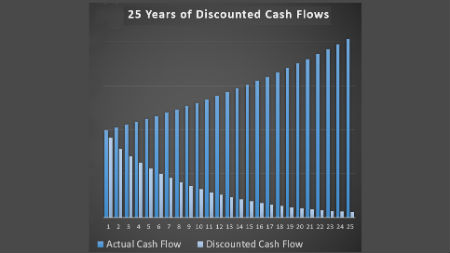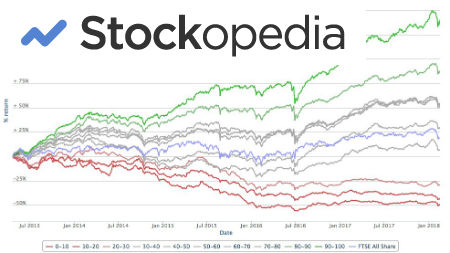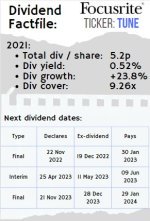Retirement Investment Plans - what should they look like?
Interview with James Sumpter, Tilney BestInvest

James Sumpter is one of London's leading experts in retirement investment plans. He is a partner at Tilney Bestinvest, Chartered Financial Planner and Fellow of the Chartered Insurance Institute. Tilney Bestinvest has been recognised as having the best risk-adjusted return of the top 50 best investment managers in the UK.
I sat down with James to pick his brains and find out what makes for successful retirement investment plans. These were his top tips:
William John: So, James, a bit of background first: what kind of clients do you work with?
James Sumpter: They're pretty much all private clients, so it's their money. They're typically self-made people - either professionals or business owners.
William John: Is there a minimum threshold before someone qualifies for your service?
James Sumpter: As a company Tilney deals in London with clients who have investible assets of more than £500,000 (US$625,000) or earn in excess of £250,000 (US$320,000) per year, and I now as one of the senior partners in London predominantly only deal with those who have more than £2 million (US$2.5 million) invested.
William John: What ages are they generally - do you work with people throughout their working lives?
James Sumpter: Yes - I have clients who are 35 years old and clients who are 90.
William John: So you see it all the way through drawing up initial retirement investment plans to transitioning into retirement?
James Sumpter: Yes - my clients are split roughly 50/50. Half are still working and half are retired - accumulating or de-accumulating as we call it in the business.
We formulate a strategic plan for every client, so if they're still working, the plan is built with a set retirement age in mind and we work through how we can build up their capital and also what sort of levels we need to get to and therefore what their retirement will look like.
For retired clients, it's more straightforward because their capital is already built up and it's just a question of how and how quickly to withdraw it.
The main question when it comes to retirement investment plans is how much each client want to have invested in the stock market and how much they would like to have in other investments. We always recommend that they keep a certain amount in cash as an insurance policy against stock market crashes.
Putting together sensible retirement investing plans comes down to how much risk you're willing to live with and what your tolerance is which determines whether you want to have, say 90% investment in equities or 20%.
William John: At what point do you start time do you start looking at that risk strategy with a person who's in their 40s or 50s and looking to retire around age 60?
James Sumpter: It depends on the individual's tolerance, but we recommend that our clients in their 40s and 50s have most of their money in equities.
We run 7 different strategies for clients ranging from a very low risk level which we call strategy number 1 to strategy number 7 which has higher risk (but with it a greater potential for growth).
Strategy number 7 consists of very nearly 100% equities, maybe with a small amount of emerging markets debt. Strategy number 1 is about 20% equities.
Most of our working clients will be using strategy number 6 (70-80% equities and 20-30% in corporate or government bonds, commercial property or a fund which offers absolute returns) or number 7 (100% equities).
Drawing up retirement investment plans tip #1:
Diversify Geographically, but favor home currency
William John: What is the general make up of your stock market investments?
James Sumpter: The first thing we do after we've drawn up retirement investment plans is to split investments geographically - between the UK, US, Europe, Japan, Asia Pacific and emerging markets for the safety that diversification brings and we would have a bias towards the UK for UK-based clients for currency reasons.
We tend to buy large-cap global companies, and we can get diversification without currency risk if we invest in global companies whose income is derived internationally but which are listed on the London Stock Exchange. We research thoroughly where the revenue comes from for each company we invest in.
William John: How do you go about that?
James Sumpter: Well, we're lucky that we have considerable amounts invested via fund managers and we can simply ask for a percentage split of where all of the revenue comes from.
William John: And you try to balance that out over a variety of geographies?
James Sumpter: Yes - we get down to specific numbers so we can tell each client for example: 18% of the revenue comes from the UK, 46% comes from the US, 27% is from Asia Pacific and China and so on.
WJ: And that should help you to protect your clients' investments from a local recession, for example?
James Sumpter: Yes - we can say to clients for example: "Even though the UK is making a complete mess of Brexit, it won't have a massive impact on your investments".
Drawing up retirement investment plans tip #2:
Consider Property, but not too much of it
William John: How much do you look at property as a model in your retirement investment plans?
James Sumpter: Well for starters, we can only invest into commercial property due to regulation, but a lot of our clients will have their own buy-to-let investments and we factor that into their asset allocation. Many of our clients own a couple of investment properties or keep their old house when they move into a larger house. We factor that in when we analyse their asset allocation.
William John: And you're looking again for a spread of investments in different asset classes?
James Sumpter: Yes - I would say that quite a lot of our clients are over-invested now in buy-to-let property because it has done so well in the recent past in the UK, but the outlook at the moment isn't that rosy.
We invest for our clients directly into commercial property via commercial property funds which own large office buildings in the Southeast of England such as the one I'm talking to you from. They generally give a yield of 3-4%. We have also been looking at commercial investment properties outside of the obvious London area and looking at warehouse companies to invest some of our clients' funds. That's becoming increasingly popular as an investment.
William John: And that would be available to a private investor through property funds, right?
James Sumpter: Yes - you could invest through funds such as the Tritax Big Box REIT, which is one of the funds we use. Typically commercial property makes up about 10% of our client portfolios. The downside of them is that they're very illiquid; they can shut the door on you, so for example after the Brexit vote in 2016 quite a lot of the commercial property companies we use said: "you can't exit", so that's obviously not ideal as you would want the ability to shift asset classes around.
In general in property we look to have a blend of different investments: commercial property, warehouse space and also social housing. Quite a lot of local authorities in the UK now outsource investments in social housing which guarantee rents, which means you're not really buying property... in effect you're buying a guaranteed income from the government. They currently offer a yield of about 5% which is guaranteed to increase by inflation and underwritten by the UK government - it's a pretty decent deal, and because it's government backed, some of the factors which affect prices and rents in the residential market won't affect these investments.
Drawing up retirement investment plans tip #3:
Don't take too long investing a lump sum (time in the market is King!)
William John: How do you go about investing large sums for your clients - I know sequence risk is a big issue in that situation. Do you use dollar cost averaging?
James Sumpter: Yes - if you were to walk through our doors with your entire assets in cash, then we would invest quickly in the things we view as low risk, such as commercial property and bonds, because the yields on those are better than on cash and the capital values are less volatile, so that would be invested in the first month or two. We phase investments into equities over the course of a year, usually in 4 chunks separated by 3-month gaps.
William John: What's the rationale for doing it in 4 chunks?
James Sumpter: We don't believe we can call the market - nobody knows what the UK or US markets are going to do in a year's time and we don't think there is anyone out there who really does, so we spread out the investments just to reduce exposure to the risk of a sudden drop in prices.
We would, however, react to the market during that period - so if there were a crash during this investment phase, we'd speed up the investments. For example at the end of 2018-19, the market dropped 10%, so we had conversations with clients who were in the investing phase to recommend that they speed up the investing. Conversely, if you're investing over a period of time and the market is roaring upwards, you might lengthen the investment process.
William John: What's the longest period of time you'd want to invest over - would you ever go over a year?
James Sumpter: Sometimes yes - 18 months would be about the maximum. Eventually though we want our clients to be fully invested in whatever asset classes we and they have settled on because time in the market is the most important thing. If you look at the stats - if you miss the 10 best days over the last 20 years, you'd miss out on about one-third of the returns. So investing over a period of time is more a psychological factor, because most investors would find it difficult to bear if they've given you all of their cash, but after a month the value of the investments we might have made for them have fallen by 20%. So it's more for security, than thinking that delaying the investment is likely to give you a better outcome.
William John: One of the people we have been covering recently is the founder of Vanguard, Jack Bogle. He believed you should have roughly your age in years equal to the percentage of bonds in your portfolio. What do you feel about that - if say I'm 60 years old, I should have 60% of my investment in bonds and 40% in equities?
James Sumpter: In the nearly 20 years that I've been working in client investments, 2 elements have changed: firstly the rules about how you withdraw money and secondly if you look at the clients that I look after, they typically aren't going to spend all their money before they die, so actually a lot of them have twin objectives - to sustain their own lifestyle and also to help their children and grandchildren and therefore their time horizon goes beyond the end of their life, so actually a 75 year-old with life expectancy of another 13 years might well be thinking about their grandchildren who may not need the cash for at least 20 years, so that extended time horizon changes the situation; you can no longer say: "you're a bit older, you should have more of your cash in secure, fixed-yield investments to take out the equity risk."
William John: Is that because people are just a bit wealthier than they used to be, so the possibilities with their retirement investment plans have changed?
James Sumpter: Yes - the generation of people who are retiring now are the first large generation who have wealth beyond their needs. It was a tiny percentage 40 years ago; now it's a much larger percentage.
Drawing up retirement investment plans tip #4:
Don't blindly follow the 4% withdrawal rule in retirement
William John: The second change you said you'd noticed was withdrawal rates - is the good old 4% rule no longer the deal?
James Sumpter: We have done a lot of work on withdrawal rates and things have changed due to the review of the law (in the UK) which means that UK residents no longer need to buy an annuity. Up until 2011, you had no choice but to buy an annuity when you reached the age of 75, so the theory was that you had take out equity fluctuation risk over the course of leading up to that point. But now that has all been removed and annuity rates are so much lower post financial crisis, due to being more-or-less fixed to interest rates, this means that most of my clients will never buy an annuity - but instead will keep their money invest all their lives. They don't have to go through the process of de-risking. Now we advise our clients to go from a risk strategy 5 to a strategy 4, for example. In other words they're only selling 10-20% of their equities.
William John: So for clarity, what does your "strategy 5" and "strategy 4" look like?
James Sumpter: Strategy 5 at the moment is 64% equities and 36% in fixed income and commercial property. Strategy 4, which is probably our most popular amongst retired clients is currently 53% in equities, although it would usually be a touch lower in the 40-50% range.
William John: Do you make the same investments for all your clients in an "off-the-peg" type approach or is it personalised dependent on the retirement investment plans of each client?
James Sumpter: If you have less than £250,000 in investible assets, you go into a fund that we run which invests cash in all areas. If - like most of our clients - you have more to invest, then we will design for you a bespoke portfolio, but we are still guided by our strategies, so even though we may have 1,000 clients currently in strategy 4, almost all of their portfolios will be slightly different. They each have an investment manager who keeps their portfolios within the boundaries of what our Asset Allocation Committee decides is the best position for each asset class and each risk strategy in the current economic climate.
We work by investing in different managed funds and we have a "Fund Buy List" of about 300 funds we have selected and each portfolio has to have 20-30 funds in it.
William John: So you use funds rather than investing in the equities themselves?
James Sumpter: In London, we most often use funds, but elsewhere the stockbroker model is still the way people operate, so there we invest for our clients directly into stocks. Most of the analysis that we've done has shown that the risk-reward trade off between investing in stocks and investing in funds is not good. We have a small research team and we argue that we are better off outsourcing that work to fund managers and what we do is screen the fund universe to find the 150 or so people we think are really good at picking stocks and if we can't find any or can't find any in a particular region, then we simply buy a tracker fund.
Drawing up retirement investment plans tip #5:
Don't pay fund managers' fees, unless you know they're worth it
William John: Do you think therefore that fund managers are worth the fees?
James Sumpter: Well, most of them aren't, but some of them we think are worth it and we invest our clients' wealth with those.
William John: When you spot a fund manager you believe in and invest with, how often do you find you've got it wrong?
James Sumpter: We have done quite a bit of analysis of this. What we do is to look over a rolling 10-year period, and for funds which are in our generic risk strategy pots (i.e. not our bespoke portfolios), we run a continuous comparison between what the performance would have been if we'd invested in trackers only versus what the fund managers actually produced, so we can monitor whether the fund managers we selected (and by extension our service) added value. We spend a lot of money on their fees so we need to know that they are worth it!
 Neil Woodford
Neil WoodfordOver the last 10 years we had an average out-performance of 2.4% over trackers in all of those indices - so that's the difference between simply investing in tracker funds and doing what we do, which is a mixture of tracker funds and active funds. That said, there are certainly fund managers you back who don't go so well, for example Neil Woodford in the UK who has had a rapid fall from grace after being a shining example of a market-defying fund manager.
Our approach is that we start by assuming that fund managers don't add any value to retirement investment plans and then we crunch all the numbers to find those fund managers who have had a track record which shows that they have added some value. We check that this happens over a good period of time and that they didn't just "get lucky", we then go and meet them to understand how they selected their investments and we then ask ourselves whether we believe in that process and whether it can be repeated. Generally we're looking for fund managers who have a quite concentrated list of stocks. The reason we think that most fund managers under-perform the index is that they're too close to it, so for example a fund manager owns too many stocks - say 100 - then we have to ask "how different are you from the FTSE 100?" and what are your fees being used for? If a fund manager is prepared to take a stance and make a decision to to pick say 50 stocks, then you have both a greater chance of over-performing and under-performing. Our view is that only those who have a concentrated list of stocks stand a chance of outperforming the market.
However, we are patient, because we realise that with such a strategy there will be years in the market when they under-perform, especially when the market as a whole market rallies or when particular sectors rally, such as banking and mining, and there are a lot of fund managers who don't like holding those kinds of stocks, so they will under-perform. You just have to accept that, but having some trackers will offset that to a degree.
Continue reading this interview >
Got a BURNING dividend question for 6-figure dividend earner Mike Roberts?
What is it that you really want to know about investing?
Submit a query and Mike will write a page in response.
PLEASE NOTE - in accordance with our terms of use, responses are meant for education / interest only. We do not give specific financial advice.



